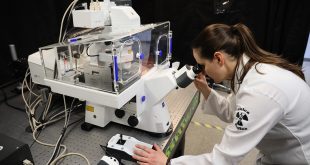By Abigail Cukier
We asked, they answered
In late January, a Toronto man who had travelled to Wuhan, China – the epicentre of COVID-19 – was diagnosed with Canada’s first presumptive case of the virus. Since then, there have been more than 500,000 confirmed cases (as of mid-December), and almost 15,000 deaths. The pandemic continues to affect almost every aspect of life in Canada and around the world. BioLab Business reached out to a variety of public health and biotech experts to look at the impact of COVID-19 on the scientific industry, as well as Canada’s strengths and weaknesses in responding to the virus and how we can be prepared for the next pandemic.
Dr. Ronald St. John
Served as the first Director General of the Centre for Emergency Preparedness and Response at the Public Health Agency of Canada
What is Canada’s weak spot, and greatest strength, in the fight against COVID-19?
Canada has had a lot of strengths in terms of people’s compliance with our recommendations. People have listened and we had a period in which we almost flattened the curve. Compared to a lot of countries, we have fared well, especially on a per capita basis.
I think the weakest spot we have is complacency, as well as misinformation. The public health community is relatively slow and not as creative as the people who push out conspiracy theories and bogus treatments and concerns about vaccines, and all that kind of stuff. They are very fast and they play on emotion and they use anecdotes, the study of one. Public health doesn’t like to do studies of one. We like to do studies of hundreds of thousands, so we tend to be slow off the start. And we are also playing catch-up with social media and the unfortunate misinformation that gets pushed through on those channels.
Complacency is also an issue. I think there’s so much pressure to move towards opening an economy that it may happen too fast and we will see a rebound [editor’s note: these comments were received before the “second wave” began]. The virus is totally dependent on our individual behaviours and our collective behaviours because we don’t have anything else to control this virus. And if those behaviours change and they loosen up, then the virus is right there.
How can we better prepare for the next pandemic?
The easy answer is, we can’t. When I was first Director General of the Centre for Emergency Preparedness and Response at the Public Health Agency of Canada, we talked about being prepared for all hazards and all possibilities. But I told the Minister, we can’t prepare for Armageddon because no one knows what Armageddon will be. So we prepare for things that happen every year in Canada. We know we’re going to have floods in the spring. We know we’re going to have forest fires in summer. We know we’re going to have outbreaks of some disease. And we prepare for those kinds of things.
That means planning, it means training and the use of the incident management system for responding to a situation. We did have a pandemic plan for influenza. And unfortunately, I don’t know how many people read that plan or were familiar with the plan. But the trouble with plans is, unless you practice them, they end up dusty on the shelf. And there’s a tendency when nothing is happening to stop practicing. Governments are very fond of providing lots of money when something is happening, and you can see that with COVID-19. But governments sometimes pull back when there’s nothing happening, and that’s the time when you should be investing in preparedness and planning, training and simulating.
Jason Field
President and CEO of Life Sciences Ontario
What have been the immediate impacts of the pandemic on the scientific industry?
I’ve observed a shift in the public perception of science. For years, we’ve seen public trust in science deteriorating and the rise of misinformation, such as the anti-vaccine movement. But COVID-19 has thrust science back into the spotlight, and I think the sector has done a remarkable job at communicating the complexity of the science to the masses. We’ve seen politicians, public health officials and frontline workers leading the charge on communicating what citizens need to do to bend the curve. Scientists are explaining the complexities of developing vaccines and how the industry is working to accelerate this process without sacrificing safety. My hope is that the public and their elected representatives take this knowledge with them beyond the pandemic and continue to recognize the importance of investing in the life sciences sector.
What is Canada’s weak spot, and greatest strength, in the fight against COVID?
Canada’s response to COVID-19 has been excellent. Governments at all levels have mobilized quickly to respond with enormous support programs; however, this rapid response has created some gaps in support. Many life sciences small- and medium-sized enterprises and startups are pre-revenue, and therefore are not able to access many of the emergency support programs. These types of companies represent the next generation of innovative health technologies and need support to ensure their survival through these challenging times.
What can science and government do better?
Work together. Prior to COVID-19, there has been a somewhat adversarial relationship between governments and private life sciences firms, particularly pharmaceutical companies. But what COVID-19 has shown us is that we need to hit the reset button on this relationship. Governments at all levels need to collaborate and partner with the private sector to help accelerate the development and adoption of new health technologies and strengthen both our health system and economy – and not just during a health crisis.
How can we better prepare for the next pandemic?
We need a coordinated life sciences strategy, one that provides adequate investments in research, commercialization and adoption – one that is forward-looking and recognizes the importance of emerging technologies such as genomics, cell therapy, artificial intelligence and digital health.
Is funding keeping up with the need for research?
No. There has been an enormous shift of resources towards COVID-19-related research, but it has been somewhat at the cost of investments into other areas of health research. For example, many health charities have seen contributions reduced by 30 to 50 percent. This is millions of dollars that would otherwise go to supporting research into other areas of health, like cancer, diabetes and heart disease.
Andrew Casey
President and CEO, BIOTECanada
How has COVID-19 disrupted, but also boosted, the scientific industry?
We need vaccines and therapeutics. Those are all going to come out of the biotech industry, so it became an exciting place to work, because we are all working towards that. That’s what’s going to allow us to return to a kind of normal. It’s been quite exciting to be at the forefront and create some sort of hope and optimism.
What can the scientific industry and government do better?
We have a long history of innovation in science and research in this country, and we’ve got fantastic scientists and researchers. I think that’s led to some great companies. Where we’re falling behind is in not taking a lot of companies across the finish line, so we’re seeing them being sold off to other companies. It would be great for Canada to start developing some companies that are grown to become commercial and become anchor companies in Canada. Think about BlackBerry in Kitchener-Waterloo and what that has done to that area, where it is now a tech hub.
What we need to do is create some BlackBerry-like companies in the life sciences space that grow and become commercial on a global scale, and then that will create spinoffs, in terms of people, but also other ideas and other companies.
That’s where we are kind of falling short, and then that leads back to why? One reason for this, probably the biggest one, is we need more investment capital. We’ve got a pretty robust venture capital system with some great companies, but we need more critical capital partners and bigger volumes of cash.
We have asked in our pre-budget submission for the federal government to invest $500 million in a dedicated life sciences fund. This would attract other investment from outside Canada and ideally, large institutional investors. That would help address the other challenge, which is access to talent. We need to do a better job of attracting people, and keeping the great scientists and researchers we are developing at our great universities. Quite often, the way to do that is to pay them properly. We are competing with U.S. companies with U.S. dollars. They tend to have deeper pockets as well, because there is more investment there.
One thing is fairly clear: There are going to be some sectors of the economy that are going to be very slow to recover, or not return at all. So what is going to substitute for those things in the economy while they are on the mend? I think that is what biotech can represent. It could be the cornerstone upon which you can build. It is also strategically important work, if you are thinking about the next pandemic or healthcare crisis. It helps us from a healthcare aspect, as well as an economic standpoint.
Tracey Maconachie
Deputy Minister, Economic Development and Training, Manitoba
What can the scientific industry and government do better?
Governments have been really supportive of novel science and technology in terms of making investments. But when it comes to actually buying the goods, there has not always been a connection between, “We invested millions of dollars in this company and now they’ve made this treatment” and then the government says, “Well no, we’re not interested in procuring it because it’s novel and nobody’s ever used it before.” But we spent millions of dollars to develop it, why wouldn’t you want Canadians to have access to it? So there’s a disconnect between the investments they make in developing products and the purchase of these for the good of Canadians.
I think they need to recognize that they are tied together and we need to support companies, not only for the development and the early commercialization, but also by being the first customer.
We have companies who developed technologies and say my first customer is going to be in Europe or China, because I can actually get my product on the market there. To get it on the market in Canada is almost impossible. Not because it’s dangerous, but because our procurement process is so challenging.
Our health system procures for very specific items. They procure for yellow pencils with black pointed tips and pink erasers, rather than procuring for writing devices. Our procurement process doesn’t say, “Do you have a new way of managing diabetes?” It says, if you have a diabetes treatment, you can put it into the queue. But if it’s more expensive than the old ones, we’re not going to look at it. It’s very, very targeted, and that makes it really difficult if you have something that nobody’s ever done before. And that’s what a lot of Canadian companies are building, something nobody’s done before.
How can we better prepare for the next pandemic?
We need to find ways to look at our supply chain within procurement. We were put at risk and still to some extent are, because most of our supply chain is from outside of Canada. And we need to say, is it worth paying a little bit of a premium to have a product made in Canada as our preferred supplier? Rather than relying on an outside supplier, could we actually have a local company producing gowns or gloves or some of those key essential pieces? What can we do to be more self-sufficient? Other countries, too – we were all very global. That doesn’t work in a pandemic.
Are there companies or researchers that might be “flying under the radar” but making a big difference in COVID-19 research?
There are so many that are doing amazing things. And sometimes, somebody is doing research and determines that their theory is not true – that actually makes a difference. There were researchers across Canada who proved hydroxychloroquine wasn’t actually a treatment for COVID-19, so we could stop doing that research and direct it in other areas. So sometimes, making a difference isn’t hitting a homerun – sometimes, it’s about getting an answer and being able to move on to the other thing.
Because of the timelines and the urgency, some researchers are going back to old school things and saying, this was good 30 years ago, would it be good now and how can we repurpose it? There has been research around using Heparin potentially as a treatment, or going back and finding old models for ventilators that can be useful.
Those are all different ways of looking at research, and not just being focused on the vaccine or the treatment. We need to find the little wins. That’s what’s going to get us to the point where we can go back to close to normal as a community.
Dr. Monika Dutt
Public health specialist and family physician in Sydney, Nova Scotia
What is Canada’s weak spot, and greatest strength, in the fight against COVID?
I think the biggest thing is that public health is chronically underfunded. It’s funded at like two to five percent of a healthcare budget, so despite getting a lot of attention right now, that’s a huge weakness. We haven’t invested in the past, even with all the reports that came out after significant events. Will we continue the same cycle? So to me, beyond thinking about what exciting new technology are we using, do we even have the starting point to support a strong public health system?
I think as a country, we had generally effective responses and managed to keep illness and death at a manageable level. At the same time, we know that some people, especially those who are elderly and some racialized groups and others, are disproportionately affected. The weaknesses and the inequities that existed before continued right on into the pandemic.
How can we better prepare for the next pandemic?
We have been very focused on the infection and transmission and very specific aspects of the virus, but it’s the social and economic policies that create healthier communities that make us better able to deal with stresses like this. So policies like access to childcare and access to a livable income are the kind of things we want to put in place, so that people aren’t at the greater risk they might be should something like this come along in the future.
Eric Morrissette
Chief, Media Relations, Public Health Agency of Canada
What is Canada’s weak spot, and greatest strength, in the fight against COVID-19?
To respond to this pandemic, federal, provincial and territorial governments in Canada undertook an unprecedented whole-of-government approach, along with significant global engagement and collaboration. Canada flattened the curve for COVID-19 and our acute care system was not overwhelmed. This was due to the efforts of health leaders from around the country, continually communicating, coordinating and cooperating with us at the federal level. Public health authorities across Canada at all levels of government worked diligently to adapt Canada’s response to the rapidly changing situation and reacted quickly to evolving evidence as we rolled out decisions and recommendations.
Going forward, establishing effective protections in vulnerable settings and an increase in science-based decision-making for the more complete, timely and integrated data will be essential.
Because of inequalities in our society, some densely populated living and working environments are particularly vulnerable to the spread of this virus. This includes long-term care homes. We saw that residents of long-term care homes are especially vulnerable to the impacts of COVID-19. We cannot, and should not, accept the status quo for long-term care homes. That is why governments across Canada have made commitments to do more. Taking care of these higher-risk individuals is essential to our country’s handling of the pandemic and in keeping rates of severe illness and death as low as possible.
What can science and government do better?
The rapidly evolving knowledge of COVID-19, combined with local and regional differences, raises notable challenges in developing and updating evidence-informed guidance to all Canadians on how to protect themselves against this virus. The Government of Canada is striving to effectively adapt public health measures, policies and guidance with this fast-evolving state of medical knowledge. There is a constant need to communicate how science, research and innovation work so that Canadians are better prepared to recognize sound and reputable recommendations. Providing Canadians with credible sources of information about COVID-19 through a variety of means, including regular press briefings, web information, advertising and social media, are important ways we combat misinformation.
The Government of Canada has made significant investments in science and research related to COVID-19. There is an ongoing need to also better understand the indirect social and economic consequences of the epidemic.
How can we better prepare for the next pandemic?
Every pandemic is different in terms of characteristics, like spread, severity of disease and which people are most vulnerable. As Dr. Tam has noted, if you have seen one pandemic, then you have only seen one pandemic.
While the Public Health Agency of Canada has been a part of Canada’s response to other pandemics, COVID-19 is unlike any pandemic the world has experienced in over 100 years. Like all novel viruses, there are many unknowns and more information is being discovered each day. Ongoing research efforts from the scientific community are pivotal to our response to this pandemic.
In Canada, the SARS pandemic in particular highlighted the importance of interprovincial collaboration, and the COVID-19 pandemic is providing the opportunity to put those lessons into practice. Canada’s current response to COVID-19 was guided by the FPT Public Health Response Plan for Biological Events, which was approved by all federal-provincial-territorial (FPT) government jurisdictions in 2017 and the established FPT Canadian Pandemic Influenza Plan.
Even with these plans in place, public health authorities across Canada at all levels of government worked together to adapt Canada’s response to the rapidly changing pandemic situation. Since it is difficult to predict the science and specifics of a pandemic scenario, Canada’s response must be nimble and evolve as new evidence and best practices are developed.
Following the COVID-19 pandemic, new planning and reflections will certainly be undertaken to better incorporate lessons learned. A significant lesson concerns health equity challenges. This includes addressing ageism, racism and ableism, which have become woven throughout our society, and are reflective of who has been hardest hit from this pandemic. The lessons learned from this pandemic will help us continue to improve mitigating negative health outcomes in our most vulnerable communities and strengthen future guidance on infection prevention and control.
Is funding keeping up with the need for research?
Canada’s response to the COVID-19 pandemic has been steadfast and based on scientific evidence. We’ve adapted our public health measures to prevent the spread of COVID-19 and provide guidance to healthcare workers so they have the appropriate tools they need to treat patients.
Yet, there is still more to learn about COVID-19. To understand this new disease, we need to advance research and technology development to slow, and eventually stop, the spread of this infection.
International collaboration in science and research is important. Canada needs to focus on its strength in research while collaborating with scientists, health organizations and partners around the world to gain knowledge and find solutions.
That is why the Government of Canada has mobilized Canada’s research and scientific communities in response to the spread of COVID-19. To date, the Government of Canada has announced more than $1 billion in support of medical research to fight COVID-19, including vaccine development, production of treatments and tracking the virus.
In worst-case scenarios, how does COVID-19 rank (i.e., is this just the tip of the iceberg)?
Pandemics of respiratory illness always rank high when looking at health risks in the population. This is driven by the size of the susceptible population, the mode of transmission of the virus – for example, respiratory, as opposed to something that is bloodborne or sexually transmitted – and the potential severity of the illness in large portions of the population, such as the elderly. COVID-19 being caused by a novel pathogen means that we are limited compared to other potential pandemic pathogens like influenza, for which we have vaccine technology in place and ready to go. Finally, the potential for spread from asymptomatic people, as has been seen with COVID-19, is an additional public health management challenge.
Dr. Charu Kaushic
Scientific Director, Institute of Infection and Immunity, Canadian Institutes of Health Research
How has COVID-19 disrupted, or even boosted, the scientific industry?
COVID-19 has been extremely disruptive to research communities across academic institutions, since universities and associated research was shut down for almost four months. Once you shut research projects for that long, it has long-term consequences on how long it takes to get projects up and going, affects graduate students’ timelines, preparation for grant applications, papers for publication. It is a domino effect; however, one area where there has been a significant boost is COVID-19 research and laboratories that study pandemic viruses, epidemiology, viral immunology and related fields. The Canadian Institutes of Health Research (CIHR), through investment from the federal government, has invested more than $165 million in new research dollars, funding 240 research grants in the last six months in the area of COVID-19 medical and social countermeasures, vaccines, diagnostics, therapeutics, clinical management and health systems, as well as social, policy and public health responses.
What do you see as immediate and long-term impacts?
The pandemic has really raised awareness among the public regarding the importance and value of science and research, which has been maybe the only silver lining! Globally, governments are realizing the importance of pandemic preparedness, too; if possible, avoid getting into this type of situation in the future. That means that science and research will receive better recognition and hopefully, better support from the public and governments.
The impact on the way research is done is profound. The speed and openness in sharing research results and data has been unprecedented, and the ability for the global research community to collaborate and move the field forward has been amazing. The work that has been accomplished in understanding the SARS-CoV-2 virus and the COVID-19 disease has been astonishing. I hope that this spirit of openness and sharing of science will carry over into the post-pandemic period.
Is funding keeping up with the need for research?
The federal government has made significant investments in research and innovation in the COVID-19 field in the last nine months. Two large investments, a total of $165 million through CIHR, have really boosted research efforts into COVID-19. The funding was all new dollars and did not affect CIHR’s annual budget and investment into other areas of research, so overall, Canadian researchers have seen a significant increase in total research funding. This will hopefully benefit both COVID-19 and non-COVID related areas.
 BioLab Business Magazine Together, we reach farther into the Canadian Science community
BioLab Business Magazine Together, we reach farther into the Canadian Science community





